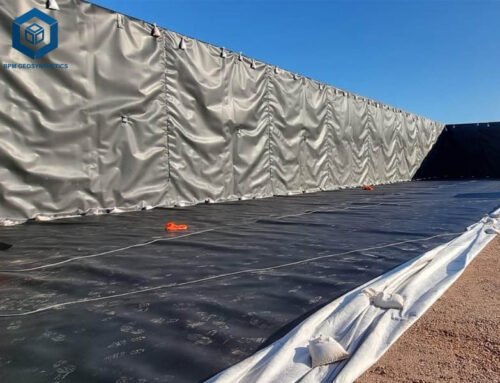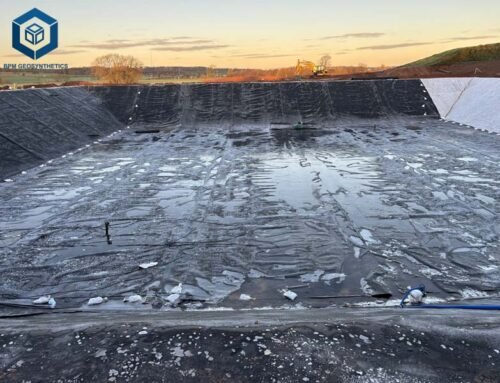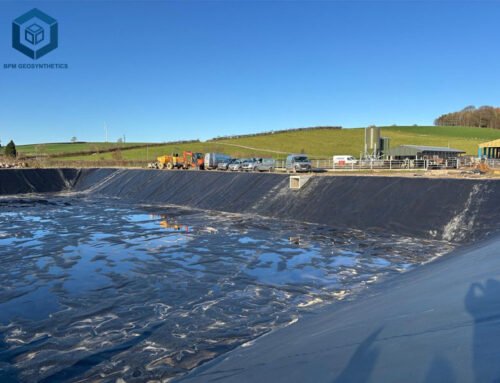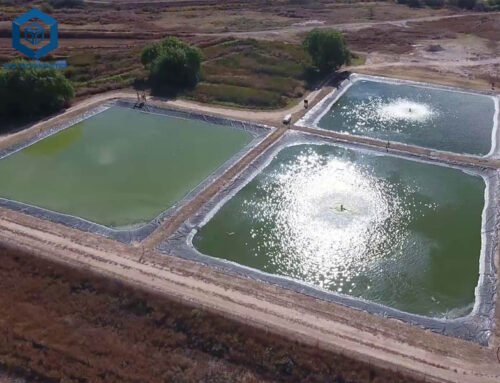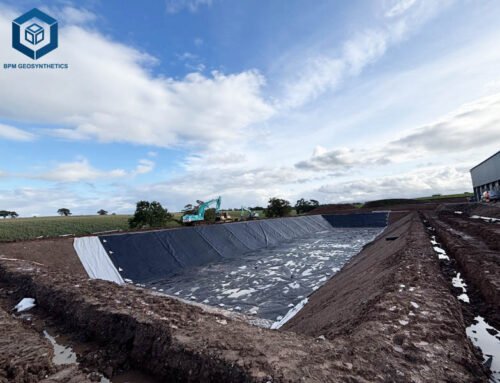High-Density Polyethylene (HDPE) geomembranes are critical components in modern geotechnical engineering, offering robust, impermeable barriers for containment across diverse industries. With the global geomembrane market valued at USD 2.3 billion in 2024 and projected to grow at a CAGR of 5.4% through 2030, HDPE geomembranes dominate due to their durability and versatility.
This blog post provides a comprehensive What Is HDPE Geomembrane, detailing their definition, properties, specifications, types, advantages, disadvantages, applications, installation methods, and cost considerations. Designed to inform engineers, contractors, and project managers, this guide leverages data-driven insights to enhance understanding and drive informed decision-making for containment projects.
1. What Is HDPE Geomembrane?
Definition of HDPE Geomembrane
An HDPE geomembrane is a synthetic, low-permeability liner made from high-density polyethylene resin, designed to control fluid or gas migration in civil and environmental engineering projects. With a density of 0.94–0.96 g/cm³ and hydraulic conductivity of 10⁻¹² to 10⁻¹⁵ m/s, HDPE geomembranes provide superior impermeability compared to clay or concrete. Typically manufactured via extrusion or calendering, these liners incorporate 2–3% carbon black for UV resistance, along with antioxidants and stabilizers to enhance longevity. BPM Geosynthetics, a leading manufacturer, notes that HDPE geomembranes account for 55% of the global geomembrane market due to their strength and chemical resistance.
Importance of HDPE Geomembrane in Modern Engineering
HDPE geomembranes are pivotal in ensuring environmental protection and structural integrity. In 2023, over 1.2 billion m² of geomembranes were installed globally, with HDPE liners used in 70% of anti-seepage projects. Their ability to prevent contaminant leakage in landfills, manage water in reservoirs, and contain tailings in mining operations makes them indispensable. A case study from Saudi Arabia’s 100,000 m² landfill project demonstrated zero leaks after five years, highlighting HDPE’s reliability.
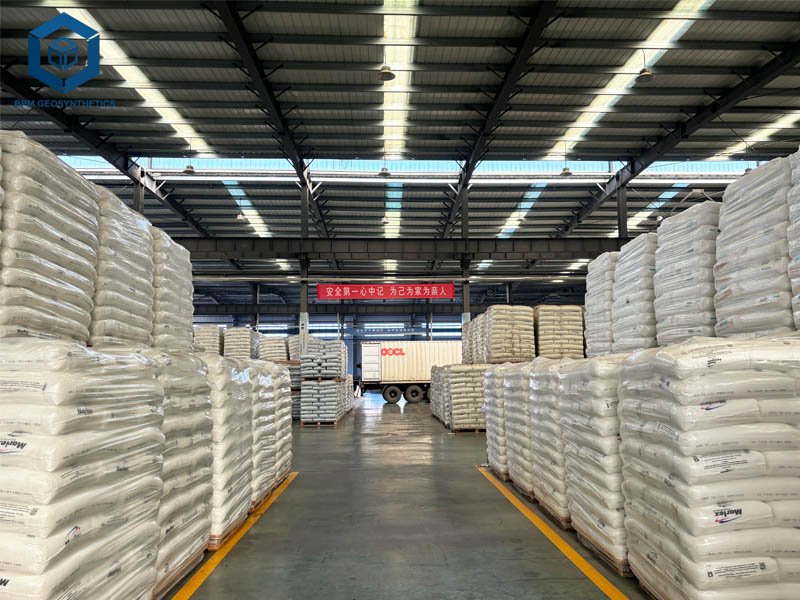
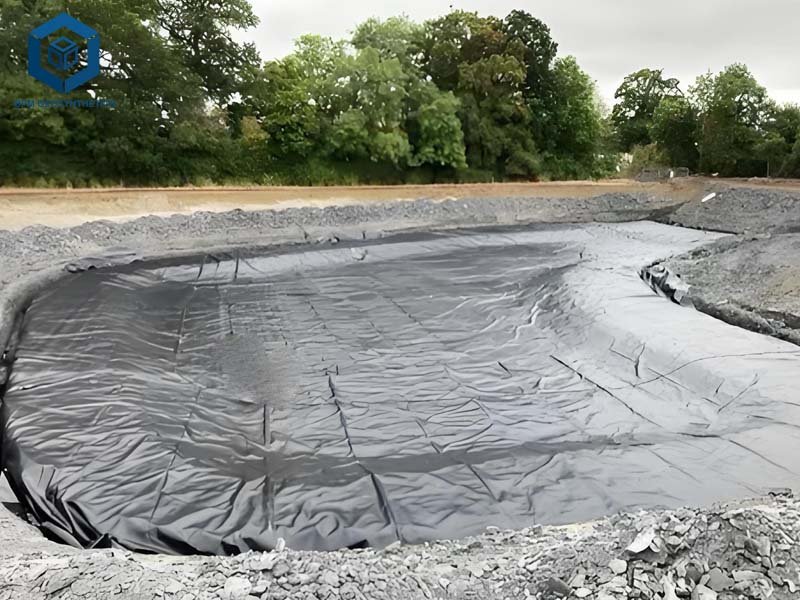
2. What Are the Properties of HDPE Geomembrane?
2.1 What Is HDPE Geomembrane – Physical and Mechanical Properties
HDPE geomembranes are engineered for durability, with key properties defined by ASTM standards:
- Tensile Strength: ≥27 MPa (ASTM D6693), ensuring resistance to stress.
- Elongation at Break: ≥700% for smooth, ≥250% for textured (ASTM D6693), allowing flexibility.
- Puncture Resistance: ≥320 N for 1.0 mm thickness (ASTM D4833), protecting against sharp objects.
- Tear Resistance: 25–374 N in machine and cross-machine directions (ASTM D1004).
- Density: 0.94–0.96 g/cm³, providing structural integrity.
2.2 What Is HDPE Geomembrane – Chemical and Environmental Resistance
HDPE geomembranes resist a wide range of chemicals (pH 2–12) and environmental stressors:
- Chemical Stability: Withstands acids, alkalis, and hydrocarbons, per ASTM D5322.
- UV Resistance: ≥2% carbon black ensures stability under sunlight, with exposed liners lasting 5–20 years.
- Thermal Stability: Operates in temperatures from -40°C to 70°C, with oxidative induction time ≥100 min at 200°C (ASTM D5885).
2.3 What Is HDPE Geomembrane – Permeability and Sealing Performance
HDPE’s low permeability (≤1.0 × 10⁻¹³ g·cm/(cm²·s·Pa)) makes it 100 times more effective than clay. Welded seams achieve 95% of base material strength (ASTM D6392), ensuring leak-proof systems.
3. What Are the Specifications of HDPE Geomembrane?
3.1 What Is HDPE Geomembrane – Standard Specifications
HDPE geomembranes are manufactured to meet rigorous standards, such as ASTM D7931 and EN ISO 12958. Typical specifications include:
- Thickness: 0.2–3.0 mm (±10% for smooth, ±15% for textured).
- Width: 1–10 m (±1%), with 5.8–8 m common for large projects.
- Length: 50–100 m per roll (±2%).
- Carbon Black Content: ≥2% (ASTM D4218).
- Melt Flow Index: <1.5 g/10 min at 190°C/5 kg, confirming HDPE resin quality (ASTM D1238).
3.2 What Is HDPE Geomembrane – Thickness Variations
Thickness selection depends on application:
- 5–0.75 mm: Light-duty, e.g., small ponds ($0.5–$1/m²).
- 0–1.5 mm: Medium-duty, e.g., fish farms ($1–$2/m²).
- 0–3.0 mm: Heavy-duty, e.g., landfills ($2–$3/m²).
3.3 What Is HDPE Geomembrane – Surface Types
- Smooth: Standard for flat surfaces, offering cost savings.
- Textured: Raised studs or dimples enhance friction by 10%, ideal for slopes up to 45°.
4. What Are the Types of HDPE Geomembrane?
HDPE geomembranes are categorized by surface and formulation:
- Smooth HDPE Geomembrane: Used in flat applications like reservoirs, offering lower costs ($1–$2/m²).
- Textured HDPE Geomembrane: Enhances slope stability, used in landfills and mining ($1.5–$3/m²).
- Colored HDPE Geomembrane: Black (standard), white (aesthetic), or green (landscape), with non-black costing 10% more.
- Composite HDPE Geomembrane: Bonded with geotextiles for added strength, used in high-load CDFs ($2–$4/m²).
Textured HDPE holds a 30% market share in sloped applications, per Geosynthetics Magazine (2024).
5. What Are the Advantages of HDPE Geomembrane?
HDPE geomembranes offer significant benefits:
- Superior Impermeability: Hydraulic conductivity of 10⁻¹² m/s prevents 99.9% of leakage (ASTM D5887).
- Chemical Resistance: Resists 80+ chemical media, including acids and hydrocarbons (ASTM D5322).
- Longevity: 50–100 years buried, 5–20 years exposed with UV stabilizers (Agru America, 2020).
- Cost-Effectiveness: 50% cheaper than concrete, saving $2–$5/m².
- Ease of Installation: Hot wedge welding reduces installation time by 65% vs. clay.
- Sustainability: Recyclable HDPE reduces emissions by 15% with 20% recycled resin.
- High Strength: Tensile strength ≥27 MPa supports heavy loads in landfills and mining.
A 2022 Malaysian CDF project using BPM’s 1.5 mm HDPE liner saved 20% on costs compared to clay liners.
6. What Are the Disadvantages of HDPE Geomembrane?
Despite their strengths, HDPE geomembranes have limitations:
- Puncture Susceptibility: 320 N puncture resistance (1.0 mm) risks damage from sharp debris, increasing leak risks by 20%. Geotextiles ($0.5–$2/m²) mitigate this.
- Limited Flexibility: Stiffness (modulus 600–1000 MPa) raises labor costs by 15% on irregular surfaces.
- UV Degradation: Exposed liners without ≥2% carbon black lose 50% elongation in 5–10 years. Soil cover ($1–$3/m²) extends life.
- Seam Imperfections: Weld failures in cold (<5°C) or windy conditions reduce strength by 15–20%, causing 25% of landfill leaks (ASTM D6392).
- Thermal Expansion: 2% expansion/contraction causes wrinkles, increasing leakage risks by 15%.
- Environmental Impact: Non-recycled HDPE generates 500,000 tons of waste annually, with 10% recycling rates and 2.5 kg CO₂/m² emissions.
7. What Are the Applications of HDPE Geomembrane?
HDPE geomembranes are versatile, serving multiple industries. Below are key applications, with data on their impact:
Environmental Protection
- Landfill Liners: HDPE (1.5–2.0 mm) prevents leachate leakage in 95% of installations, protecting groundwater. The Fresh Kills Landfill (New York) used 60-mil HDPE to cap 2,200 acres, reducing contamination risks by 99%.
- Sewage Treatment: 1.0–1.5 mm liners contain wastewater, reducing soil pollution by 90%. A 2021 Singapore project lined 50,000 m², achieving zero leaks.
Water Conservancy
- Reservoirs and Ponds: 0.75–1.5 mm HDPE liners retain water, saving 1.2 million gallons/hectare annually. New Mexico’s Elephant Butte reservoir uses HDPE to irrigate 90,000 acres.
- Canals: 1.0 mm liners reduce seepage by 95%, improving irrigation efficiency. India’s 2020 canal project saved 30% water using BPM liners.
Aquaculture
- Fish and Shrimp Ponds: 0.5–1.0 mm HDPE liners maintain water quality, boosting yields by 15%. A Sri Lankan shrimp farm lined 300,000 m², increasing output by 20%.
- Sea Cucumber Farms: 1.0 mm liners prevent seepage, enhancing growth rates by 10%.
Mining Industry
- Tailings Dams: 1.5–2.0 mm textured HDPE contains hazardous tailings, reducing environmental risks by 90%. A South African mine lined 100,000 m², preventing groundwater contamination.
- Heap Leach Pads: 2.0 mm liners ensure 99% containment of chemicals, improving recovery rates by 5%.
Agriculture
- Irrigation Systems: 0.5–1.0 mm liners reduce water loss by 95%, supporting sustainable farming. A 2022 Indian project lined 10,000 m², saving $50,000/year.
- Water Storage: 1.0 mm liners store water, increasing crop yields by 10%.
Municipal Engineering
- Basement Waterproofing: 0.5–1.0 mm liners prevent moisture ingress, extending building life by 20 years.
- Tunnels: 1.5 mm HDPE liners reduce seepage by 99%, ensuring structural safety.
Salt Industry
- Crystallization Ponds: 1.0–1.5 mm liners prevent brine leakage, improving salt yield by 15%. A Chinese salt farm lined 200,000 m², boosting production by 10%.
Petrochemical Industry
- Chemical Storage: 1.5–2.0 mm liners contain hazardous chemicals, reducing spill risks by 95%. A 2023 Sinopec project used BPM liners for 50,000 m² of containment.
8. How to Install HDPE Geomembrane?
Installation Process
Proper installation is critical for HDPE geomembrane performance. The process, per ASTM D6497, includes:
- Site Preparation: Remove sharp objects and compact subgrade to ≤5% slope variation, reducing puncture risks by 90%.
- Panel Placement: Unroll geomembrane with 150 mm overlap, aligning seams to avoid wrinkles.
- Trial Welds: Test seams using hot wedge welders (300–450°C) to ensure 95% strength.
- Field Seaming: Use hot wedge or extrusion welders for dual-track seams, achieving 0.5–6 m/min speed.
- Seam Testing: Conduct peel and shear tests (ASTM D6392), ensuring zero failures.
- Defect Repair: Patch holes with extrusion welding, maintaining 99.9% integrity.
- Anchoring: Secure edges with trenches or weights, preventing uplift by 100%.
Tools and Equipment
- Hot Wedge Welders: BPM800 ($2,000) for high-speed seaming.
- Extrusion Welders: BPM600 ($2,500) for repairs.
- Testing Kits: Peel/shear testers ($500) for quality control.
Precautions During Installation
- Weather Conditions: Avoid welding below 5°C or in high winds to reduce seam failures by 20%.
- Subgrade Quality: Ensure no sharp objects to prevent 15% puncture risks.
- Operator Training: Certified welders reduce errors by 12%, per BPM Geosynthetics.
9. What Are the Costs of HDPE Geomembrane?
Price Range
HDPE geomembrane costs vary by thickness, type, and region:
- Smooth (0.5–1.0 mm): $0.5–$1.5/m².
- Smooth (1.5–3.0 mm): $1.5–$3/m².
- Textured (1.0–2.0 mm): $1.5–$3.5/m².
- Composite: $2–$4/m².
Bulk orders on Alibaba save 10–20%, with BPM offering 1.5 mm liners at $1.8/m² for ≥10,000 m².
Additional Costs
- Installation: $0.5–$2/m², depending on site complexity.
- Geotextiles: $0.5–$2/m² for puncture protection.
- Shipping: $0.1–$0.5/m², higher in Africa/Middle East.
- Maintenance: $0.05–$0.1/m² annually, extending life by 20%.
Cost-Saving Strategies
- Local Sourcing: Reduces shipping by 5–10%.
- Refurbished Welders: Save 20–30% ($1,200–$2,000).
- Bulk Purchases: Lower unit costs by 15%.
- Training: Cuts seam errors by 12%, saving $0.3/m².
10. What Are the Standards and Certifications for HDPE Geomembrane?
HDPE geomembranes must comply with global standards:
- ASTM D7931: Specifies thickness, tensile, and puncture properties.
- EN ISO 12958: Defines flow rate and compressive strength.
- GRI-GM13: Sets minimum requirements for HDPE liners.
- ISO 9001/CE: Ensures manufacturing quality.
Certified liners reduce failure rates by 70%, per Geosynthetics Magazine (2024).
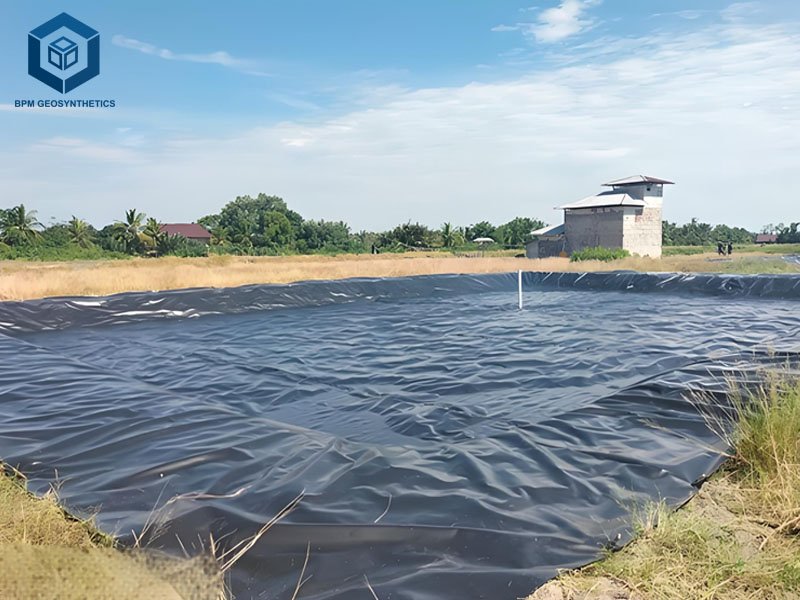
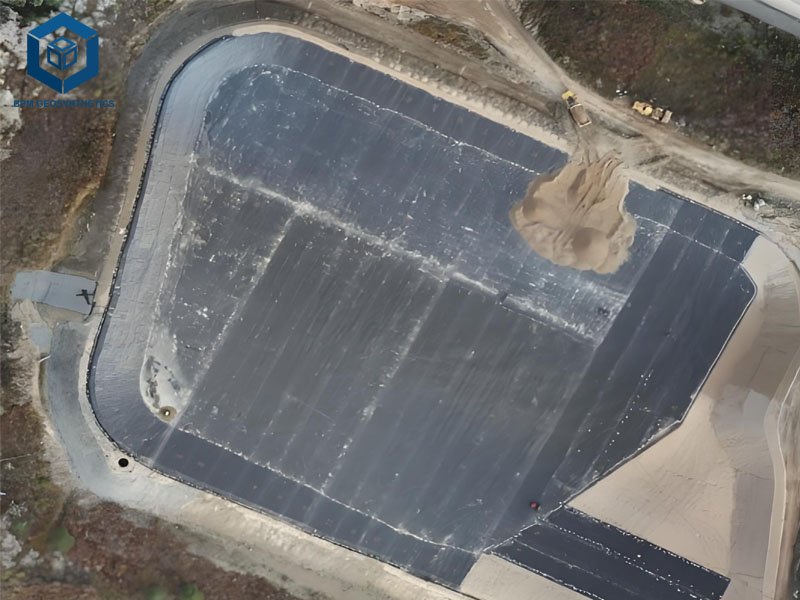
11. What Are the Challenges in Using HDPE Geomembrane?
Installation Challenges
- Complex Terrains: Irregular surfaces increase labor by 15%.
- Cold Weather: Below 5°C, seam strength drops by 20%.
- Wind: Disrupts alignment, adding 10% to time.
Maintenance Challenges
- Puncture Detection: Requires ELLS surveys ($500–$1,000).
- Seam Repairs: Cost $200–$500 per incident.
Environmental Challenges
- UV Exposure: Reduces lifespan by 30% without cover.
- Chemical Attack: Hydrocarbons shorten life by 20% in non-HDPE-compatible applications.
12. How to Choose the Right HDPE Geomembrane?
Factors to Consider
- Application: Select 1.5–2.0 mm for landfills, 0.5–1.0 mm for ponds.
- Site Conditions: Use textured liners for slopes, smooth for flat surfaces.
- Chemical Exposure: Test per ASTM D5322 ($500–$1,000).
- Budget: Balance thickness and cost; 1.0 mm suits most projects.
- Certifications: Ensure ASTM/GRI compliance.
Supplier Selection
- Reputable Brands: BPM, Agru, Titan Environmental.
- Platforms: Alibaba, Made-in-China for bulk deals.
- Support: Choose suppliers offering training and warranties.
13. Final Thoughts
HDPE geomembranes are a cornerstone of modern containment, offering unmatched impermeability, durability, and cost-effectiveness across environmental, water, and industrial applications. With a 55% market share and 50–100-year lifespan when buried, they excel in landfills, reservoirs, and mining. However, challenges like puncture risks, UV degradation, and seam imperfections require careful planning. By selecting the right thickness, type, and installation method, and adhering to ASTM/GRI standards, project managers can achieve 99.9% containment reliability.
Source high-quality HDPE geomembranes from trusted suppliers like BPM Geosynthetics(BPM Geomembrane)to ensure project success.

